African Life – Oct 1961
(The following article is re-produced from African Life (October 1961) and written by David Evans (see Staff)
‘Smile School’ air girls have no time for the giggles’
by DAVID EVANS,
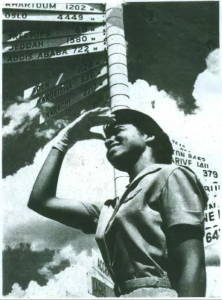 It is 10 years since East African Airways introduced male African Cabin Service Attendants on internal routes. Now, for the first time, African girls are among a score of stewardesses being trained to serve passengers on both internal and international services.
It is 10 years since East African Airways introduced male African Cabin Service Attendants on internal routes. Now, for the first time, African girls are among a score of stewardesses being trained to serve passengers on both internal and international services.
What does an airline look for when selecting it’s stewardesses? The ideal applicant 1s about 23 years old, 5ft. 5in. tall and possesses a sound general education — her chances of success are limited unless she can speak two or more languages.
A knowledge of nursing or first-aid – is always an asset, and so is previous catering experience, while essentials are a smart appearance, commendable deportment, practical ability and originality, articulate speech, a lively personality, a good memory and, above all, a marked aptitude for the work. Tact, diplomacy and common sense are of the greatest importance. Out of 500 written applications received by East African Airways each year, about 25 girls are accepted for training. Usually replacement courses occur every three months, for about six girls, but occasionally, as the airline expands, it is necessary to organise an extra course to meet the new requirements. More than 20 girls are at present undergoing eight weeks’ training at Nairobi Airport.
Many aspiring stewardesses mar their chances either when writing their original letter of application or when they complete the forms sent to them-the main shortcomings being careless spelling, poor composition, illegibility of name or address, combined with giving some flippant reason for wanting to be a stewardess. Such motives as “enjoying free travel,” “be able to go home more often,” “buy clothes cheaper in other places” and “I’d have more chances of meeting a wealthy husband,” are not likely to impress airline officials.
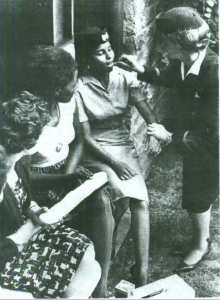
Often-and even by some of the applicants themselves-an air stewardess‘ job is regarded as being essentially glamorous, a life spent drifting about the globe, casually attending to sleepy V.I.P.s, grinning film stars and portly business executives. But this is an illusion.
It is hard work, beginning from the moment a stewardess boards the aircraft to check all equipment, dry stores and supplies for the flight, long before the passengers are called, until she checks the bar account after bidding them goodbye.
As the public becomes more sophisticated and air travel is taken more for granted, the majority of passengers are ordinary people pursuing their day-to-day occupations rather than celebrities flitting among exotic bright lights. A broader cross-section of the public, with a wider variety of opinions, habits; tastes and diets, now plies the densening sky routes. But each of them, down to the precocious 13-year-old travelling alone back to school and blissfully demanding champagne cocktails, expects ~ sympathetic consideration..
And, however irritating a stewardess may be by the tiresome behaviour of young children in flighty, she must not resort to a remark like “Why don’t you kids step outside and play?” Whatever the circumstances she must remain composed, attentive and polite – which is remarkably difficult.
Occasionally a passenger makes an observation which makes her eyebrows rise. One elderly lady, after visiting the powder room situated close to a freight hold containing a consignment of day-old chicks, cheerfully remarked, “Fancy that! A sparrow has flown into the toilet!” The stewardess caught the wandering, wingless chick and showed it to her, saying with a smile, ‘‘Isn’t it cute?”, before returning it to the hold. The passenger immediately realised her mistake and was amused and grateful to the stewardess for her tactful, though tacit, explanation.
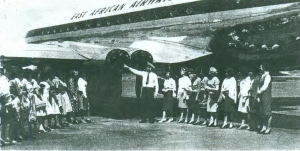
When the aspiring stewardess has completed and returned her application forms these are examined carefully and suitable candidates are invited to attend a preliminary interview. Then a short list is prepared and a final interview held before a selection board consisting of the Cabin Services Manager, the Chief Stewardess and the Establishment Officer. At this stage, special consideration is given to appearance, speech and the confidence which an applicant may inspire.
Those finally selected undergo a medical examination before beginning training, the course usually starting within some four weeks of the selection board. Stewardesses, according to Shelly Berman, ” have an inexorable smile . . . they’ve been to smile school : all other expressions have been brainwashed out of them . . . . ” By the time a girl has been through E.A.A. training school and undergone a further six months of combined ground and flight training, taking periodic written and oral examinations before receiving the coveted stewardess wings, she is barely in a frame of mind to smile at all.
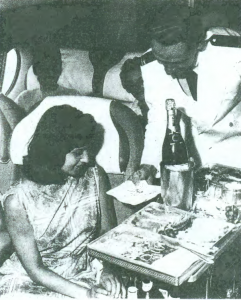
The training programme is rigorous, involving both theory and practice. It includes lectures on airport procedure, airline organisation, route familiarisation, background of aviation, flight pressurisation, dressing of aircraft, currency and immigration regulations, cargo, first aid, sales and ticketing, as well as instruction on care of children, dietetics, modes of passenger address, hygiene in food handling, food uplifts, catering, bar service and, most important of all, a sound grounding in passenger psychology.

Ltd. at Nairobi Airport.
BACK TO THE CLASSROOM
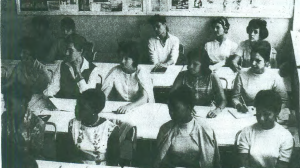
The girls are taught that any airline’s reputation depends largely upon the ability of its Cabin Service staff to please the passengers. Even if passengers’ demands appear to be insatiable there are innumerable ways of ensuring their gratitude, either by tactfully suggesting alternatives or by use of charm and general attentiveness. But if there are a number of ways of pleasing a passenger, there are endless ways of creating, in the most docile of them, an almost permanent antipathy to the airline and all it stands for. A mere splash of hot coffee on a suit or nylon stockings can destroy in one careless moment the combined efforts and months of work of the whole airline organisation. E.A.A. ‘s stewardesses represent, particularly to foreign visitors, not only the national airline but also East African area which hopes to put tourism at the head of its list of producers of the national income. So the trainees try to learn as much as possible about East Africa’s unique and abundant tourist attractions, as well as elementary statistics on populations, distances, heights of major mountains and airfields.
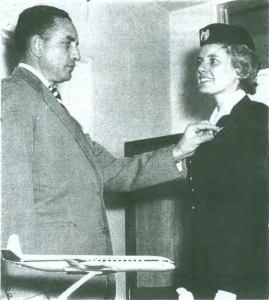
Next year East African Airways expects to carry, on all routes, some 200,000 passengers. For most of them the only airline representatives they remember will be the stewards and stewardesses who care for them in flight. Much depends on these ambassadors from “smile school”
Probably 150,000 meals and 250,000 refreshment services involving the handling of 2,250,000 pieces of equipment, will be served to passengers in 1962 by a total cabin staff of only 90 stewards and stewardesses.
When she is not serving meals, a stewardess is briefing passengers, answering questions, preparing meals, arranging trays, washing up and paying extra attention to young children, invalids, elderly people and mothers with babies-at almost any hour of the clay or night. ·
To unkind observers it may seem that the stewardess lives a glamorous and exciting life, with time to relax while “the workers” jostle each other during the daily rush hours. They forget that while they themselves are sleeping soundly in the homes, the stewardess is soaring through the air at eight mites a minute towards London or Bombay, constantly attending to the comfort of her passengers.
